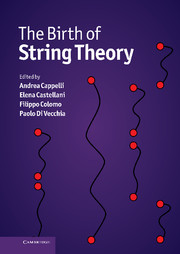Book contents
- Frontmatter
- Contents
- List of contributors
- Photographs of contributors
- Preface
- Abbreviations and acronyms
- Part I Overview
- EARLY STRING THEORY
- Part II The prehistory: the analytic S-matrix
- Part III The Dual Resonance Model
- Part IV The string
- 19 Introduction to Part IV
- 20 From dual models to relativistic strings
- 21 The first string theory: personal recollections
- 22 The string picture of the Veneziano model
- 23 From the S-matrix to string theory
- 24 The analogue model for string amplitudes
- 25 Factorization in dual models and functional integration in string theory
- 26 The hadronic origins of string theory
- TOWARDS MODERN STRING THEORY
- Part V Beyond the bosonic string
- Part VI The superstring
- Part VII Preparing the string renaissance
- Appendix A Theoretical tools of the Sixties
- Appendix B The Veneziano amplitude
- Appendix C From the string action to the Dual Resonance Model
- Appendix D World-sheet and target-space supersymmetry
- Appendix E The field theory limit
- Index
23 - From the S-matrix to string theory
from Part IV - The string
Published online by Cambridge University Press: 05 May 2012
- Frontmatter
- Contents
- List of contributors
- Photographs of contributors
- Preface
- Abbreviations and acronyms
- Part I Overview
- EARLY STRING THEORY
- Part II The prehistory: the analytic S-matrix
- Part III The Dual Resonance Model
- Part IV The string
- 19 Introduction to Part IV
- 20 From dual models to relativistic strings
- 21 The first string theory: personal recollections
- 22 The string picture of the Veneziano model
- 23 From the S-matrix to string theory
- 24 The analogue model for string amplitudes
- 25 Factorization in dual models and functional integration in string theory
- 26 The hadronic origins of string theory
- TOWARDS MODERN STRING THEORY
- Part V Beyond the bosonic string
- Part VI The superstring
- Part VII Preparing the string renaissance
- Appendix A Theoretical tools of the Sixties
- Appendix B The Veneziano amplitude
- Appendix C From the string action to the Dual Resonance Model
- Appendix D World-sheet and target-space supersymmetry
- Appendix E The field theory limit
- Index
Summary
String theory traces its origin to the Veneziano model of 1968. It also happens that the Weinberg–Salam model was born about the same time. The latter has led to the successful Standard Model. The descendants of the former, on the other hand, are still struggling to be relevant to the real world in spite of their enormous theoretical appeal. Indeed there exist two pathways in the development of theoretical particle physics since its beginnings in the Thirties. I will call them the quantum field theory and the S-matrix theory respectively. In its historical lineage, the Standard Model belongs to the former, whereas the superstring theory belongs to the latter. Even though the former has turned out to be the Royal Road of particle physics, this was not entirely clear before its final triumph, and the latter has also played very important contributing roles which continue to this day. The purpose of this note is to follow this other pathway and discuss the topics that have influenced my thoughts.
In the Thirties, when nuclear physics was developing, there were uncertainties in the minds of physicists about the efficacy of quantum field theory which was still in its early stages of development. For one thing, quantum field theory had inherited the self-energy difficulty from classical theory although the degree of divergence was found to be milder. For another, the unknown nature of nuclear forces and the much higher energy range involved than in atomic phenomena made people suspect that quantum mechanics might fail in dealing with nuclear phenomena, just as the classical theory failed with atomic phenomena.
- Type
- Chapter
- Information
- The Birth of String Theory , pp. 275 - 282Publisher: Cambridge University PressPrint publication year: 2012
- 3
- Cited by



